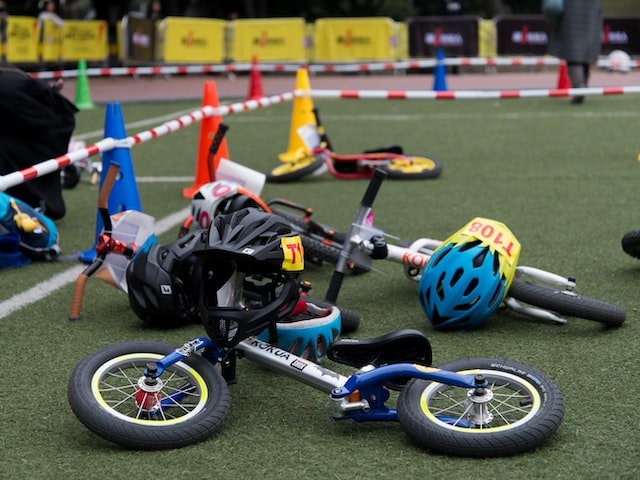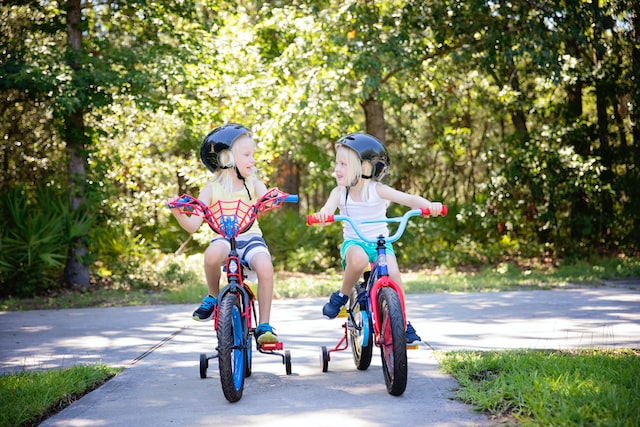
I have a confession to make; I did a terrible job getting my kids’ first bikes. I had no idea what to look for and quickly settled for the free hand-me-down. Who’s going to turn down a perfectly good, lightly used, free bike? It even came with training wheels!
The big day came, and we were ready to have our first bike riding lesson. Let’s just say, it wasn’t a day for the scrap book. Everyone was frustrated, my son quickly lost interest, and we called it a day after about 15 minutes.
Unfortunately, the experience was so bad for all parties involved that we put off trying to learn to ride bikes for too long. My son turned 9, and the parent alarm went off in my head that I really needed to do something about this.
After a lot of research, I have since learned about the balance bike (sometimes called a glider bike). But if your kid already has a bike, do you really need to buy a balance bike?
Generally, it is a good choice to buy a balance bike for toddlers, preschoolers, and young kids. Balance bikes are available in smaller sizes and fit younger kids better than the smallest pedal bikes. If you already have a pedal bike that fits your child, you do not need to buy a balance bike. You can remove the pedals and convert your pedal bike into a balance bike.
If you look at the fundamental steps to learning to ride a bike, you need to learn balance, steering, and then pedaling in that order. Let’s go ahead and stipulate that a balance bike is an excellent option for young children to learn to ride a bike. The big question is, do I really need to buy one? Let’s look at some of the pros and cons to purchasing a balance bike.
Pros to Buying a Balance Bike
1. You have a bike specifically designed for beginner riders
One lesson I’ve learned working around the house with my dad is how much easier things are when you have the right tools. Balance bikes are the perfect tool for very young riders. They accommodate their size and follow the natural learning pattern of young children.
The seat is much lower and can work for kids as young as 18 months old. The height for a seat on a balance bike can go as low as 10 inches, versus 17 inches for the smallest common pedal bike. The weight is generally half that of a pedal bike and much easier for young kids to move around.

2. You can use a balance bike at a much younger age
Balance bikes follow the natural exploratory learning pattern of young children. They begin by simply walking with the bike, and before you know it, they’re gliding. And this usually happens with minimal instruction. There’s no need for training wheels or walking behind your child. They simply use their feet, and there are no pedals in the way to trip them up.
3. You can start going on family bike rides much sooner
You’ll find that young children gain confidence quickly with a balance bike. Because it is much simpler, they will progress further, sooner. They are more adventurous, ride at faster speeds, and are more independent. You can all go for a ride together because you aren’t walking behind them to help them balance.
A child learning to ride a bike with training wheels is slow moving. Because they’re trying to navigate balancing and pedaling, they’re usually moving very slowly. Turning is cumbersome with pedals and training wheels, especially because young children struggle to build speed and momentum.
4. Prices for balance bikes have gotten much more reasonable
Balance bikes used to be a super niche item. That’s not the case anymore, and there are many more affordable options available. The Strider bike (a classic go to option for a balance bike) starts at around $100 for a base model (with many options that can get more expensive). Now you can find other brands on Amazon for as little as $60. That’s not a bad option if you’re going to buy one for a 2-year-old that will get 2-3 years of use out of it.
Cons to Buying a Balance Bike
1. Your kids will outgrow them
This is true with just about everything you buy your kids. That said, a balance bike is essentially a uni-tasker. It’s a great uni-tasker and teaches balance effectively. But the truth is, at some point you will need to buy a pedal bike.
You might be able to make the most out of a balance bike purchase if you buy it when your child is super young and then size up when they get bigger. But depending on the size balance bike you get (they come in a 10-inch wheel size) and how high you can adjust the seat (some can go higher than others), your first pedal bike size might be the same size as your balance bike. (Bike sizes are measured by wheel size. To learn more about finding the right size bike check out Picking the Right Bike for Your Kid (Find the Perfect Fit).
They do make conversion bikes that can be both a balance bike and a pedal bike. It is a nice sounding feature, but once again, your child will outgrow it. There is an element of risk when deciding to pay more money for a feature that your child may outgrow and never use.

2. It’s not a good option for older kids still learning to ride a bike.
Bike manufacturers make larger balance bikes, but they tend to be more expensive than their toddler counterparts.
Many older kids find the balance bike to be too juvenile, especially if their friends are riding pedal bikes. The moment they figure out how to balance on a bike, your older child is going to want to move onto a pedal bike.
While a toddler might ride a balance bike for a couple years, an older kid will move on much quicker. A larger balance bike is a bigger uni-tasker that you child will stop using much sooner.
3. You can make a temporary balance bike using a pedal bike
Remember, the sequence of learning to ride a bike is balance, steering, then pedaling. You can accomplish this by using a pedal bike and taking off the pedals (find out how here: Turn a Pedal Bike into a Balance Bike).
This is how I taught my two boys how to ride a bike. Both were older when they learned, and both were gifted bikes with training wheels. Training wheels didn’t help at all, but buying two more bikes just to teach them how to balance was not a viable option. Once they learned how to balance and steer, I put the pedals back on.
4. Some models of balance bikes are prone to warping if not properly cared for.
Some manufacturers make wooden, eco-friendly balance bikes. While this sounds like a nice idea (I mean, no one actively wants to hurt the environment), the truth is it’s an outdoor toy made of wood. If a wooden toy isn’t properly taken care of and stored indoors, it’s more prone to warping.
If you decide to go this route, take care of it. What good is your gesture to help the environment if you end up throwing the bike away? Especially since you can pass a metal bike down to another kid and get multiple uses out of it. Just sayin’.
The Dad Stuff Recommendation
Let me stipulate once more that a balance bike is an excellent (and I would argue the best) way to teach a kid to ride a bike. Purchasing one, however, may or may not be the best option for you and depends on your situation.
If you have very young children, I recommend buying a balance bike. If they are young, they are more likely to get a couple years out of riding their balance bike. They can learn independently and have a blast riding all over the place with it. I did not go this route with my first child and wish I had.
If you are teaching kids that are a little older (pretty much beyond preschool), or they are big enough fit on a small pedal bike, I would recommend using a pedal bike and removing the pedals. Once they’ve learned how to balance, put the pedals back on.
Related Posts
Training wheels have been around forever. I know I had them when I was a kid (as did every other kid on the street), and I’m willing to bet most of you had them too. When it was time for my kids to...
Every adult has their own “how I learned to ride a bike” story. Mine's a bit blurry, but it involved training wheels, lots of crashes, and finally figuring out how to balance one day in my...
